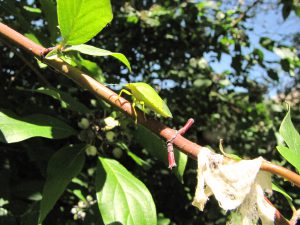Click Here to view the pdf version.
ALL FRUIT TREES
Stink Bugs
Hosts: apple, pear, peach, nectarine

Stink bug activity will escalate through the end of August and into early September: In Utah, we have several species of stink bugs. The invasive brown marmorated stink bug does occur in Utah, but it has not yet been found damaging fruit.
Late season stink bug damage appears as slightly sunken spots on the fruit skin. On apple, the flesh underneath the injury is corky and light colored. ON peach, the lesions are water-soaked. When you slice into the flesh, the damaged area forms a conical shape, with the widest area near the skin. Damage mostly occurs near the top third of the apple, and on fruits near the orchard borders or near natural areas.
Insecticides for late season stink bug management in commercial orchards include Baythroid and Leverage (both 7-day PHI) and Danitol (14-day PHI). Surround (kaolin clay) may provide some repellent activity. Start with treatment of the border rows only, and be mindful of the label’s pre-harvest. Avoid using a pyrethroid if you have spider mites, as this could make the problem worse.
PEACH/NECTARINE, APRICOT, CHERRY
Late-Season Coryneum Blight
Hosts: peach/nectarine
Coryneum infections that happen as fruit is ripening are more severe than early-season infections. Thankfully, the peach-harvest weather has been dry so far. But with every rainfall through peach harvest, the chance of late-season infections increases. A spray is only needed if at least 4 hours of rain occurs.
Brown Rot: Preventing Post-Harvest Decay
Hosts: peach/nectarine, plum
In the last few years, the disease brown rot (caused by the fungus Monilinia) has become more apparent in Utah, primarily in backyard trees but also in a few commercial orchards. It is one of the most important disease of stone fruit worldwide, but Utah’s dry summers has kept it at bay. In July and early August of 2014, northern Utah had heavy monsoonal rains that helped contribute to spread.
Monilinia thrives in warmer temperatures, but needs frequent rains during the pre-harvest period (when fruit has begun to soften) to cause disease. In some cases, 100% crop loss may occur.
Fruit infections are visible as firm, brown lesions that rapidly spread throughout the fruit causing complete decay in just a few days. Spores produced on these fruit can then disperse and infect additional healthy fruit. Fruit that is picked can appear healthy, only to rot in storage or on store shelves. In parts of the country where brown rot is common, flowers and green fruit can become infected. But in Utah, we have found that the most common infections are occurring on ripe fruit.
Where rains are predicted, fungicide applications can begin 2 to 3 weeks before predicted harvest of each variety. A second application would occur 9 days late, and a final application the day before or between pickings.
Many fungicides have a 0 or 1-day PHI and a re-entry interval of 12-24 hours, making thins timing possible. See the table on the next page for a list of options. It is important to rotate between pesticide classes to prevent resistance.
The final pre-harvest spray provides protection during the picking and transport process. It may also be very important for fresh farm market peaches, since these fruit are rarely treated with a post-harvest fungicide. If you have had brown rot identified this year or in the past, it will be important to apply a protectant fungicide to prevent infection, especially if rainfall occurs close to or at harvest.
Brown Rot and Coryneum Blight Fungicide Options
| Fungicide | Group | PHI | Also Controls | Efficacy | Resistance Risk |
|---|---|---|---|---|---|
| Topsin M (thiphanate-methyl) | 1 | 1 | powdery mildew | excellent | High |
| Indar (fenbuconazole) | 3 | 0 | powdery mildew | excellent | High |
| Rally (myclobutanil) | 3 | 0 | powdery mildew | good | High |
| Spectracide Immunox (myclobutanil) (Home use) | 3 | 0 | powdery mildew | good | High |
| Fontelis (penthiopyrad) | 7 | 0 | powdery mildew | good | High |
| Vangard (cyprodinil) | 9 | 2 | good | High | |
| Gem (trifloxystrobin) | 11 | 1 | powdery mildew | good | High |
| Quilt Xcel (propiconazole + azoxystrobin) | 3/11 | 0 | powdery mildew | excellent | Medium |
| Pristine (boscalid + pyraclostrobin) | 7/11 | 0 | powdery mildew | excellent | Medium |
| Captan (captan) (Home use) | M4 | 0 | fair | Low |
